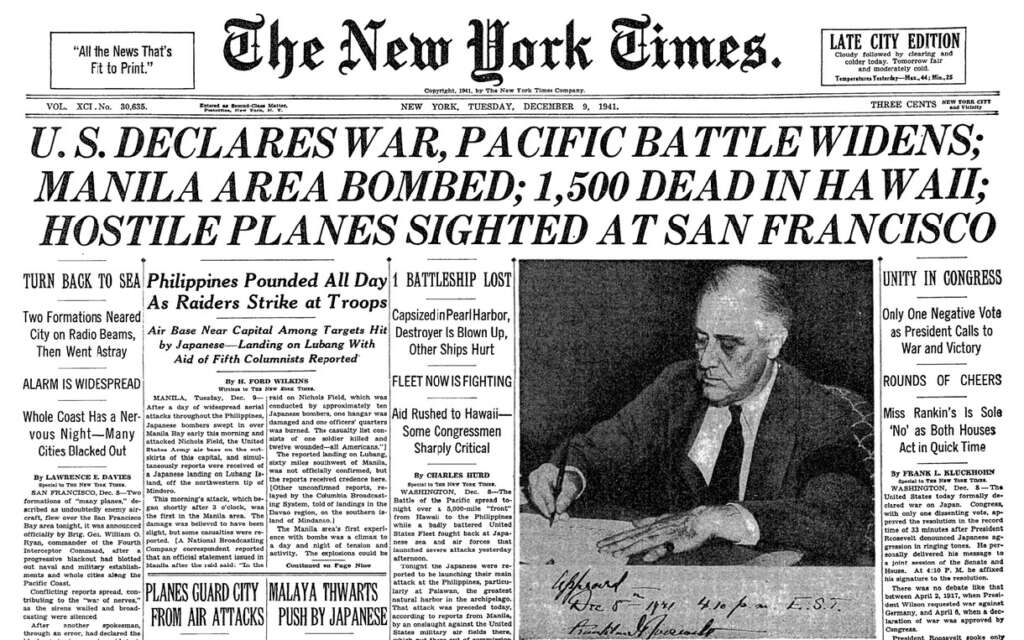Le 6 décembre 1941, Franklin Roosevelt lance un appel à l’Empereur du Japon Hirohito pour éviter la guerre dans le Pacifique (Appeal to Emperor Hirohito to Avoid War in the Pacific).
“I am certain that it will be clear to Your Majesty, as it is to me, that in seeking these great objectives both Japan and the United States should agree to eliminate any form of military threat” écrit FDR.
Le lendemain, la réponse des Japonais est celle de Pearl Harbor. L’objectif est de détruire la flotte de l’US Navy du Pacifique.
Le 7 décembre, FDR publie la proclamation 2525 – Alien Enemies, Japanese
“Now, Therefore, I, Franklin D. Roosevelt, as President of the United States, and as Commander in Chief of the Army and Navy of the United States, do hereby make public proclamation to all whom it may concern that an invasion has been perpetrated upon the territory of the United States by the Empire of Japan”.
Le 8 décembre, il s’adresse au Congrès pour faire une demande de déclaration de guerre (prérogative du Sénat)
Yesterday, December 7, 1941 – a date which will live in infamy – the United States of America was suddenly and deliberately attacked by naval and air forces of the Empire of Japan.
(…)
I ask that the Congress declare that since the unprovoked and dastardly attack by Japan on Sunday, December 7, 1941, a state of war has existed between the United States and the Japanese Empire.

Le 8 et 9 décembre, il publie les proclamations 2926 et 2527, déclarant comme ennemis les Allemands et les Italiens.
Les Américains sont entrés dans la Seconde guerre mondiale via le Pacifique, plus de deux ans après le début de la guerre.
Le 6 juin 1944, les Américains et les forces alliées, au total 156 000 soldats, débarquent sur les plages de Normandie tandis que l’armée soviétique poursuit son avancée sur le front Est.


Le 6 juin, FDR publie la Prayer on D-Day et le même jour il délivre un discours pour informer le peuple américain.
FDR D-Day Speech June 6, 1944
Dwight Eisenhower, général des forces américaines en Europe, diffuse aussi un message
CBS Reports (1964): “D-Day Plus 20 Years – Eisenhower Returns to Normandy”
D-Day: All you need to know about 1944’s Normandy Landings
Les célébrations de 1 an à 80 ans après
Histoire des commémorations du D Day : premier anniversaire : le 6 juin 1945 [feuilleton 1 / 4]
Histoire des commémorations du D Day : les années 80 [feuilleton 2/4]
Histoire des commémorations D Day : le cinquantième anniversaire en 1994 [feuilleton 3/4]
Histoire des commémorations du D Day : réconciliation avec l’Allemagne [feuilleton 4/4]
D-Day 80th Anniversary – Normandy Then and Now footage
D-Day: “The Greatest Military Operation in History”
Ed O’Donnell, historian, College of the Holy Cross
Un Américain de retour 75 ans après
Archive Video Of The D-Day Normandy Landings
DDAY – Retour à Omaha pour Jake Larson
Le jour du débarquement au Cinéma : Du jour le plus long à Il faut sauver le soldat Ryan
The Longest Day (1962)
Saving Private Ryan (1998)
